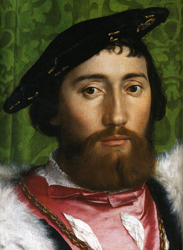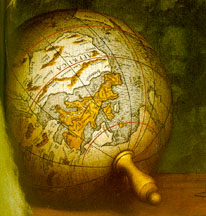

In contrast to the bourgeois roots of Georges de Selve, Jean de Dinteville was a member of the noblesse de race, or noblesse d'épée. His ancestral claims to nobility extend back to the Middle Ages. The family name can be traced back to the fourteenth century when an ancestor, Pierre de Jaucourt, adopted the name Dinteville, which was the name of his seigneurie in Champagne. Pierre's second son, Jean, settled at Polisy shortly before 1321.
Our Jean Dinteville's grandfather, Claude de Dinteville, served as the Surintendant de Finance to Charles the Bold, the Duke of Burgundy. Claude, as fitting to his position as a member of the noblesse d'épée, was killed at his master's side at the Battle of Nancy in 1477.
Jean Dinteville was born on September 21, 1504. He was the third son of Gaucher de Dinteville, Seigneur of Polisy and Bailly de Troyes. Gaucher devoted much of his career holding positions attached to the French court. While his father held the position of Premier Maître d'Hotel to the Dauphin François, Jean served as Echanson, or Cup Bearer, to the royal children between 1521 and 1524. By the end of the 1520s, Jean had succeeded his father in the position of Bailly de Troyes. As Bailly, Jean served as the king's representative in the bailliage, with responsibility for military matters and keeping order. The judicial functions formerly the responsibility of the Bailly had been taken over by other officials by the early sixteenth century. The position was largely a hereditary one held by members of the noblesse d'épée.* He became the Seigneur de Polisy in 1531 on the death of his father. It is likely that at the same time he replaced his father as a member of the Order of St. Michael.
The majority of Jean's time was devoted to attendance at court. It is here he undoubtedly met Georges de Selve. It was also here that he became introduced to the French Humanists, most notably Lefèvre d'Etaples, who in 1526 held the position of tutor to Duke of Angoulême and was working under the patronage of Francis I. The epistemological and doctrinal positions of Lefèvre , as argued here, were crucial in the creation of The Ambassadors.
Associated with Dinteville are the symbols appropriate to a member of the noblesse d'epée. He has both a sword and a dagger. The latter bears the inscription: ÆT. SVÆ 29 which corresponds to Dinteville's age in 1533:

The dagger as Dinteville's symbol is clearly opposed to the book as de Selve's, which in turn records de Selve's age. This signifies the traditional Renaissance dichotomy of the active versus the contemplative. This contrast in roles of Dinteville and de Selve as the "epée": warrior and the "robe" : clergy, judiciary, and scholar echoes contemporary representations of the court:

In this frontispiece to Antoine Macault's translation of Diodorus Siculus, to the right of Francis I appear members of the noblesse d'epée wearing clothing very similar to Dinteville, while to the left of Francis I appear members of the robe. Just to the King's left appears Cardinal Antoine Duprat, the chancellor of France since 1515. As chancellor, Duprat was the head of the judicial administration. Duprat's rise to power mirrors that of Jean de Selve. Both were the sons of merchants and had entered the legal profession. Both had worked their way up the judicial hierarchy from the parlement of Toulouse to become the first president of the parlement of Paris.* In 1515, Duprat had been appointed chancellor of Milan, while Jean de Selve was appointed as the vice-chancellor.* The ideal court needs a balance between these two functions.
Around his neck Dinteville wears the chain and medallion signifying his membership in the Order of St. Michael. This order was founded in 1469 by Louis XI (1461-1483) as an attempt to ensure the allegiance of ranking nobles.
The appearance of Polisy, Dinteville's seigneurie, on the terrestrial globe is likely a reference to the ownership of land as central to the identity of members of the noblesse d'epée. Is the globe with its reference to "Polisy" being intentionally contrasted with the merchant's arithmetic book with its reference to the accumulation of money central to bourgeois identity? Remember that de Selve's family were merchants in Limousin during the fourteenth and fifteenth centuries.
